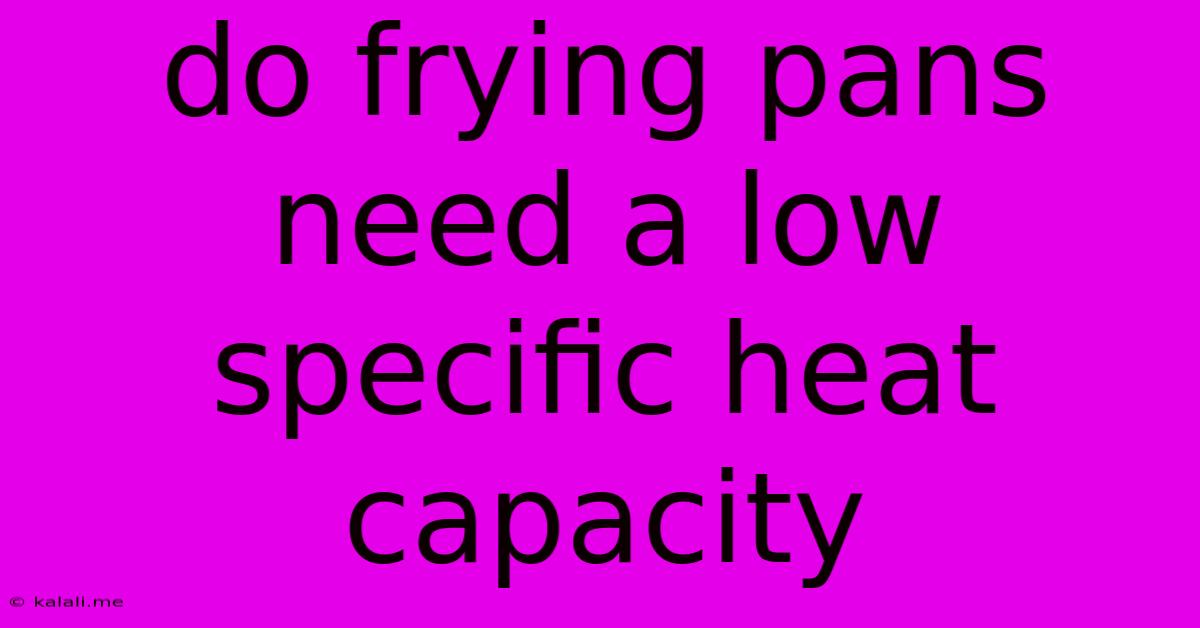Do Frying Pans Need A Low Specific Heat Capacity
Kalali
Jun 03, 2025 · 3 min read

Table of Contents
Do Frying Pans Need a Low Specific Heat Capacity? Understanding Heat Transfer in Cooking
Choosing the right frying pan can significantly impact your cooking experience. While many factors contribute to a good pan, the specific heat capacity of the material is often overlooked. This article will delve into the relationship between specific heat capacity and frying pan performance, helping you understand whether a low specific heat capacity is truly desirable. Understanding this will help you make informed decisions when buying your next pan.
What is Specific Heat Capacity?
Specific heat capacity refers to the amount of heat energy required to raise the temperature of one unit of mass (typically one gram or one kilogram) of a substance by one degree Celsius (or one Kelvin). Substances with a low specific heat capacity heat up quickly, while those with a high specific heat capacity require more energy to achieve the same temperature increase.
The Role of Specific Heat Capacity in Frying Pans
In the context of frying pans, specific heat capacity plays a crucial role in how efficiently the pan heats up and distributes heat. While a low specific heat capacity might seem ideal for rapid heating, the reality is more nuanced.
Why a Low Specific Heat Capacity Isn't Always Best:
-
Uneven Heating: Materials with very low specific heat capacities, while heating up quickly, can also cool down quickly and unevenly. This can lead to hot spots in your pan, resulting in inconsistent cooking and potentially burning your food.
-
Temperature Fluctuations: Rapid temperature changes make it difficult to maintain a consistent cooking temperature, especially crucial for delicate dishes. This is why cast iron, despite its high specific heat capacity, is prized for its ability to retain heat consistently.
-
Energy Efficiency: While a low specific heat capacity leads to fast heating, it might not translate to energy efficiency. The rapid cooling might require more frequent bursts of energy to maintain the desired cooking temperature, offsetting the initial benefit.
The Ideal Balance: Thermal Conductivity and Heat Retention
Instead of focusing solely on specific heat capacity, a better approach is to consider the overall thermal properties of the pan material. Thermal conductivity, which describes how efficiently a material transmits heat, is equally important. A good frying pan needs a material with:
-
High Thermal Conductivity: This ensures even heat distribution across the pan's surface, minimizing hot spots and promoting consistent cooking.
-
Good Heat Retention: This ensures the pan maintains a stable cooking temperature, preventing drastic temperature swings during the cooking process. This is where the specific heat capacity plays a secondary role – a moderately high specific heat capacity can contribute to better heat retention.
Popular Frying Pan Materials and Their Properties:
-
Cast Iron: High specific heat capacity, excellent heat retention, and good thermal conductivity (once seasoned).
-
Stainless Steel: Moderate specific heat capacity, good heat retention, and moderate thermal conductivity (often requires an additional layer for improved heat distribution).
-
Aluminum: Low specific heat capacity, relatively good thermal conductivity, but can suffer from uneven heating if not designed properly (often combined with other materials to address this).
-
Copper: Excellent thermal conductivity, leading to very even heating, but requires more care due to its reactivity.
Conclusion:
While a low specific heat capacity might seem attractive for quick heating, it's not the sole determinant of a good frying pan. A balance between thermal conductivity and heat retention is far more crucial for even cooking and consistent temperature control. Look for frying pans that boast high thermal conductivity and appropriate heat retention capabilities, rather than solely focusing on a low specific heat capacity. The best pan for you will depend on your cooking style and preferences, but understanding the role of these thermal properties will significantly inform your purchasing decision.
Latest Posts
Latest Posts
-
How To Make The Ken Burns Crop Go In Reverse
Jun 05, 2025
-
How To Remove Dry Wall Anchors
Jun 05, 2025
-
Brownie Mix In Mini Muffin Pan
Jun 05, 2025
-
How Long Does It Take For Wood Stain To Dry
Jun 05, 2025
-
How Do You Say Settings In Spanish
Jun 05, 2025
Related Post
Thank you for visiting our website which covers about Do Frying Pans Need A Low Specific Heat Capacity . We hope the information provided has been useful to you. Feel free to contact us if you have any questions or need further assistance. See you next time and don't miss to bookmark.